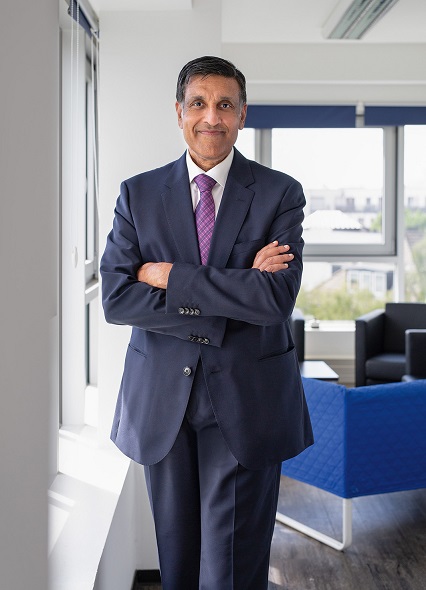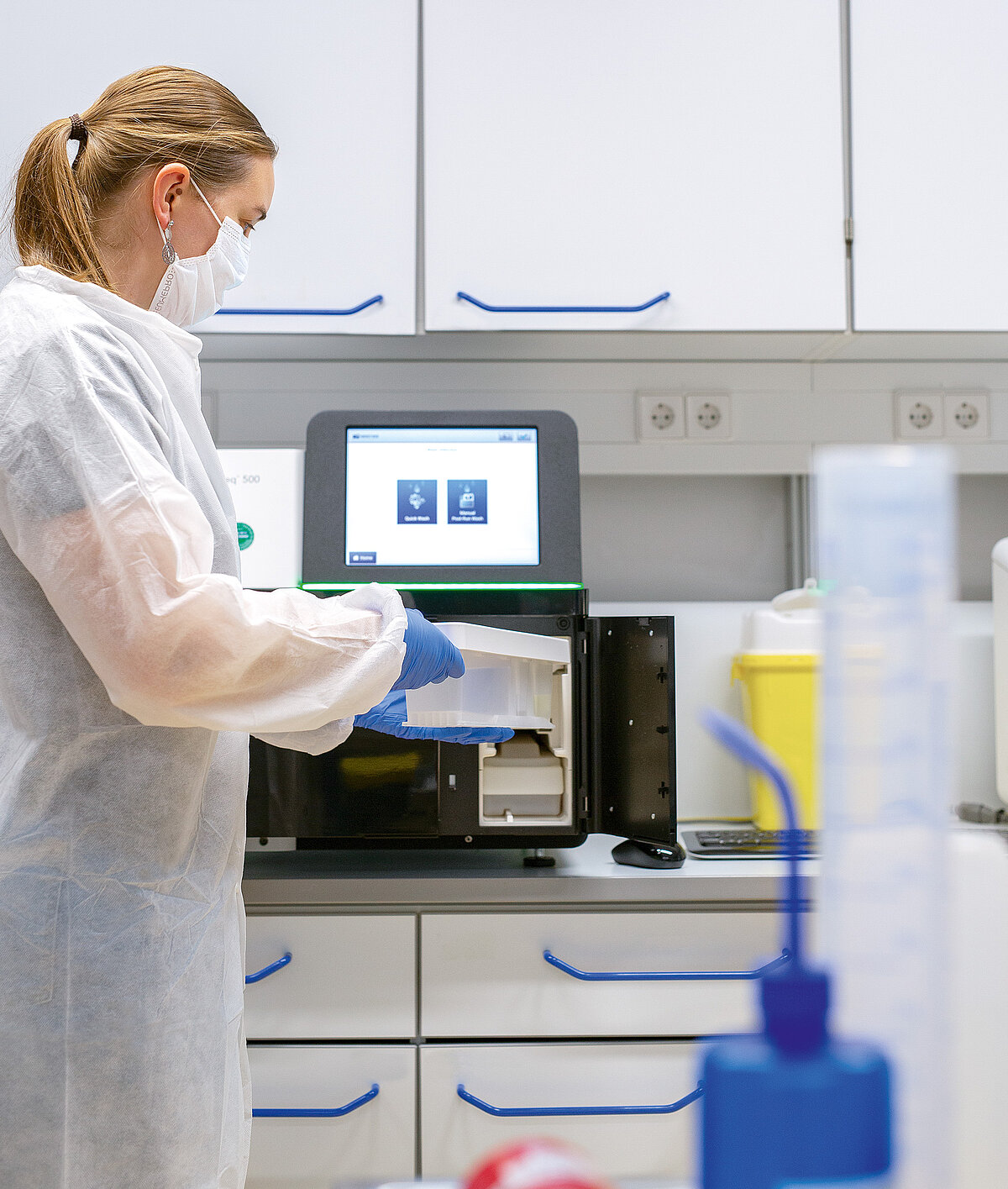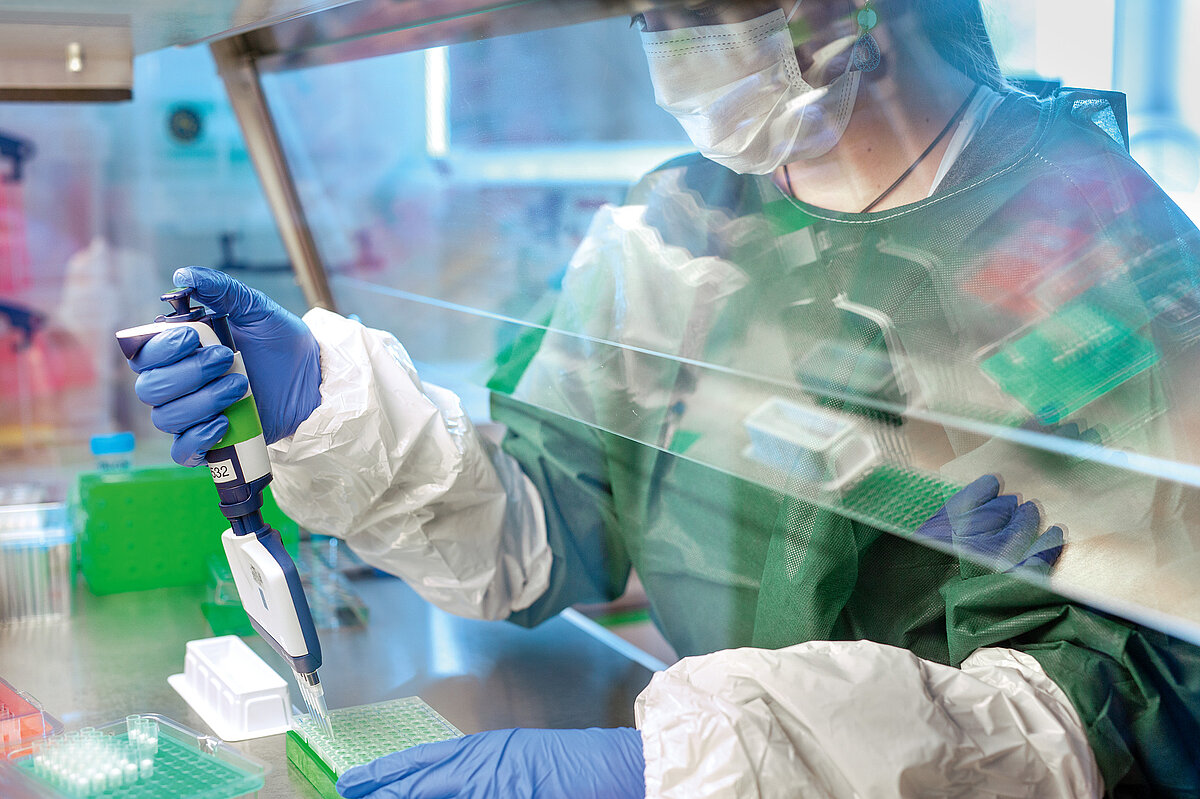Minimum invasion, maximum insight – how liquid biopsy opens new perspectives in cancer diagnostics
The article was originally featured in the 02/2021 edition of XTRA magazine. It has been translated and edited in June 2022.
The team of Dr Bhuwnesh Agrawal is at the forefront of the revolution in oncology diagnostics. Liquid biopsy (LB), the method which lies at the heart of the products offered by Sysmex Inostics GmbH, where Dr Agrawal works, promises to provide insights on cancer using just a few millilitres of blood. Are we getting closer to make this non-invasive technique a routine tool in the clinic?
As the CEO of Sysmex Inostics GmbH, how would you summarise or describe the mission of your company?
Though it is everyone’s dream to cure cancer, our initial goal is to make cancer well manageable. We want to achieve this by supporting oncologists to adapt treatments faster and more effectively. We want to be able to see whether the treatments are successful or not much earlier and whether there is a minimal residual disease after cancer surgery. This is where liquid biopsy can offer valuable information – if it is sensitive enough. It is for this reason that we have developed a series of highly sensitive liquid biopsy tests under the Plasma-SeqSensei brand which we have recently brought to the market.
Sysmex Inostics has been in the liquid biopsy business for years. How did it all start and what experience have you gained?
It all started in 2002 with the method called BEAMing developed by Bert Vogelstein Laboratory at the world-renowned Johns Hopkins University. The issue which we face when we are trying to capture the traces of tumours in the blood, is that these traces are often sparse. That is why OncoBEAM was special because it allowed us to detect these traces even if only a few mutant molecules were present in the sample. Inostics, the first liquid biopsy company was founded a few years later, in 2008, to bring BEAMing technology to the market. Soon after it has been acquired by Sysmex, we were able to launch OncoBEAM™ Kits together as companion diagnostics, conducting over 60 clinical studies with pharmaceutical companies and analysed more than 40,000 samples.
In the meantime, with the rapid development of next-generation sequencing (NGS), another technology was invented at Johns Hopkins University – SafeSEQ. This technology maintains exceptional sensitivity while allowing us to screen for a broader range of cancer mutations and further improve the turnaround time. Therefore, it was a no-brainer to base our new generation of kits on that technology. This is how the Plasma-SeqSensei (PSS) Kit was born.

In your opinion, what does liquid biopsy mean for progress in cancer diagnostics?
Liquid biopsy opens doors for the previously unexplored perspectives in cancer diagnostics. One of the main disadvantages of the traditional tissue biopsies is their invasiveness and discomfort which they cause to the patient. This also makes them expensive. A lung biopsy fails in about 30% of the time. This limits the frequency at which they can be carried out. Unfortunately, cancer is often a long-term disease, and oncologist needs a tool to monitor the patient frequently, often over many years. Liquid biopsy is a perfect solution to that problem, as blood collection is minimally invasive, uncomplicated and cheaper. Additionally, when the liquid biopsy is combined with a sensitive detection method, it allows detection of recurrence months before the conventional imaging tests can detect it.
What support does liquid biopsy provide for oncologists?
These days, with personalised medicine revolutionising medical oncology, clinicians require more molecular information about the tumour. To give a prognosis and make treatment decisions, clinicians need to understand the composition of the tumour and its clonality, and these may change during treatment. It is often observed that the primarily dominant cell clone is suppressed or eliminated by the treatment, but at the same time another cell clone which is resistant to the treatment begins to evolve. It is, therefore, important for oncologists to know which clone has become relevant to be able to target treatment individually for each patient. As we have learned the hard way, no two tumours are alike. Liquid biopsy allows a comprehensive snapshot of the tumour status and permits us to regularly monitor its changes. What is being extensively investigated by numerous clinical trials worldwide, is how the treatment decisions based on liquid biopsy results improve the long-term outcome for the patients. So far, the initial indications have been very promising.
Speaking of the patients, what is the benefit of liquid biopsy for the patients?
There are many! First, blood sample collection is minimally invasive, and there is no recovery time. Secondly, it is fast – it reduces the time of the anxious waiting for the results. For example, the turnaround time of the Plasma-SeqSensei workflow is just two days. Thirdly, with liquid biopsy, we are overcoming another shortcoming of traditional tissue biopsy sampling errors due to tumour heterogeneity. The tissue sample provides the molecular profile of the cells only from the site in which it was taken. In contrast to that, liquid biopsy originates from a pool of molecules circulating in the bloodstream. This improves the chances of capturing the full picture of cancer mutations present in the patients’ tumours including metastasis and tailoring the treatment. In addition, the high sensitivity of our liquid biopsy can reveal changes in the course of the disease earlier, allowing timely treatment adjustments, which can have a positive impact on the clinical courses.
My dream is to transform cancer from a once-terminal into a well to treatable disease
You have mentioned that recently Sysmex Inostics has developed a new next-generation sequencing-based liquid biopsy test. Could you share more about these tests?
Last year has been very exciting to us because we have launched our first kits based on the next-generation sequencing technology. We have named it Plasma-SeqSensei to underline the sample type (plasma) and the technology (sequencing) but also to show that this is a transferable technology which can be mastered by anyone with laboratory training (Sensei = master). The first edition of PSS kits has been primarily dedicated to research use (RUO), but our aim was always to bring it closer to the patient. That is why we are happy to share that we have just launched two Plasma-SeqSensei Kits which are IVD-certified: Solid Cancer IVD Kit and Breast Cancer IVD Kit. The intended use of these new kits is (neo)adjuvant response monitoring in patients, recurrence surveillance and detection of minimal residual disease. In addition, the Solid Cancer IVD Kit is intended to aid the clinician in analysing the RAS mutation status to determine the potential benefit of anti-epidermal growth factor receptor (EGFR) therapy for colorectal cancer patients.
What is the difference between the assays?
OncoBEAM™ is a fantastic test. It is based on an emulsion PCR that is read using flow cytometry. It is very sensitive, which is why it was a complete innovation for us. The new Plasma-SeqSensei™ test has a similarly high sensitivity but a much less complex workflow. Our new test is based on next-generation sequencing and can be quickly integrated into the laboratory routine. Since most laboratories have sequencing equipment and use NGS-based methods, no additional equipment investment is required. Unlike the digital PCR method which only detects specific targeted mutations, the new NGS-based test detects all changes, both known and unknown mutations, within relevant gene regions including insertions and deletions. The correlation of data between the two technologies is close to 100%, meaning that Plasma-SeqSensei™ offers the same great benefit in terms of analytical sensitivity as OncoBEAM™.
Could you give an example of how Plasma-SeqSensei Kit can be utilised in clinical routine?
Plasma-SeqSensei Solid Cancer Kit can help clinicians to determine the potential benefit of EGFR therapy through analysing RAS mutation status. RAS is a negative predictive marker for response to anti-EGFR antibodies, and only wild-type patients show benefits from anti-EGFR treatment. The plasma of such patients needs to be monitored via a highly sensitive LB test, as they often acquire resistance mutations in RAS gene during treatment. If this happens, the anti-EGFR therapy should be paused, since such patients will no longer benefit from the treatment. Plasma monitoring, however, can be carried out further, as RAS mutations may decrease again down to clearance in the absence of anti-EGFR therapy. Such patients may then benefit from another round of anti-EGFR treatment. This is what we call an anti-EGFR rechallenge therapy. In short, Plasma-SeqSensei™ Solid Cancer IVD Kit can aid clinicians to optimise mCRC therapy management via close monitoring of RAS mutation status in plasma.
There are already several NGS-based testing methods on the market. What makes Plasma-SeqSensei™ special?
NGS assays normally have an analytical sensitivity of 1%, which means that mutations are only detectable if they are present in 1% of the total DNA. Anything below this threshold is difficult to detect. We know from the literature that in 40–50% of metastatic cancer patients, a mutant allele fraction in circulating tumour DNA is less than 1% in serum. This means that conventional tests fail to detect mutations in about half of these patients. Our technology enables us to go well below 1%. We achieve an analytical sensitivity of 0.06–0.07%, which can be even lower depending on the amount of DNA used and can detect up to six mutant DNA molecules per sample.

Why are analytical sensitivity and absolute quantification so important?
With our method, even 40–50% of the metastatic patients with a mutant allele fraction below 1% can be correctly classified, meaning that these patients can receive the best therapy which would otherwise be missed. Absolute quantification is important because there is also circulating DNA in the blood that is unrelated to the tumour, and this fraction varies greatly. If we want to monitor treatment response based on the decrease in tumour DNA in the blood, we need to be able to quantify it independently from the non-tumour DNA in the blood. With Plasma-SeqSensei Kit, we can quantify tumour-specific sequences as an absolute number of mutant molecules detected in the tested volume of blood independently of cfDNA input which enables effective longitudinal monitoring.
Which laboratory can perform the test? Does it require special expertise?
In principle, any laboratory that performs sequencing can use the test. Sample preparation is simple and is based on the standard workflow in a molecular diagnostic laboratory. Some training is necessary, which we usually do remotely in about two hours. We are confident that any sequencing laboratory can set up the test with very little effort. Additionally, we offer a comprehensive bioinformatic analysis solution – Plasma-SeqSensei software. This software is an integral part of the workflow and has several advantages. Firstly, to start the analysis with PSS software, you do not need extensive bioinformatics training. The pipeline is automated, intuitive and fast. Secondly, the software can be downloaded to your local drive of a standard laptop or office computer. Thirdly, it generates a comprehensive, but easy-to-read report which can be directly sent or printed and handed over to the oncologist.
Where do you see liquid biopsy in ten years?
I hope that in ten years, liquid biopsy will be the standard in cancer diagnostics. I have been practicing for 40 years, and in the beginning, we used to give patients non-specific cytotoxic treatments. Patients died either from the disease or from the treatment. Today, I see new drugs being used in a very targeted manner with much better tolerability. I hope that in ten years, we will be even better and able to detect relapses and drug resistance as well as treatment success and failure much earlier and adapt treatment accordingly. We will be able to screen patients with minimal residual disease much earlier and treat those affected ones in a truly personalised manner. It is still my dream to transform cancer from a once-terminal disease into a well manageable, fast and treatable one in the future.

Summary
- Liquid biopsy enables blood-based monitoring of solid tumour activity, timely diagnosis and may allow oncologists to better tailor treatment for individual patients.
- With more than a decade of experience in liquid biopsy, Sysmex Inostics recently launched its new NGS-based liquid biopsy test – Plasma-SeqSensei™ – now available in two IVD-certified versions: Plasma-SeqSensei™ Solid Cancer IVD and Plasma-SeqSensei™ Breast Cancer IVD.
